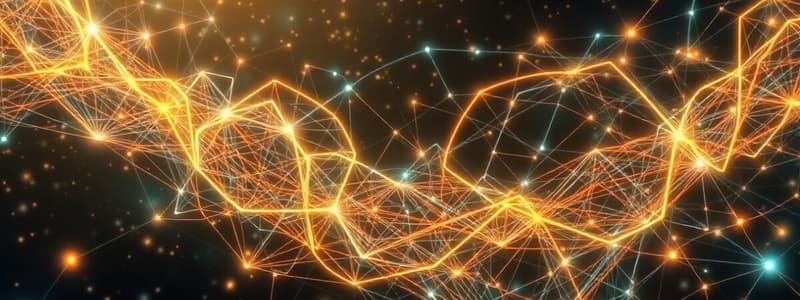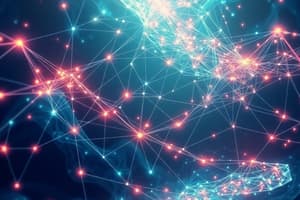Podcast
Questions and Answers
What is the main purpose of the Max-flow Min-cut Theorem?
What is the main purpose of the Max-flow Min-cut Theorem?
- To calculate the total weight of edges in a complete graph.
- To find the shortest path in a graph.
- To determine the maximum flow in a network. (correct)
- To analyze network reliability.
A ___ graph is one where every pair of vertices is connected by an edge.
A ___ graph is one where every pair of vertices is connected by an edge.
complete
In graph theory, directed graphs have edges that do not have a specified direction.
In graph theory, directed graphs have edges that do not have a specified direction.
False (B)
Which topology features a central node connected to all peripheral nodes?
Which topology features a central node connected to all peripheral nodes?
What are the two primary types of protocols used in networks?
What are the two primary types of protocols used in networks?
Match the following network protocols with their descriptions:
Match the following network protocols with their descriptions:
Dynamic networks change over time with fixed connections and capacities.
Dynamic networks change over time with fixed connections and capacities.
What is a bipartite graph?
What is a bipartite graph?
Which operation on matrices is non-commutative?
Which operation on matrices is non-commutative?
What must be true for a matrix to have an inverse?
What must be true for a matrix to have an inverse?
How are eigenvalues calculated?
How are eigenvalues calculated?
What does a controllability matrix indicate in control systems?
What does a controllability matrix indicate in control systems?
Which of the following is NOT a linear transformation?
Which of the following is NOT a linear transformation?
What does the stability of a dynamic system relate to?
What does the stability of a dynamic system relate to?
What is the result of applying Gaussian elimination to a matrix?
What is the result of applying Gaussian elimination to a matrix?
What does the identity matrix do when multiplied by another matrix?
What does the identity matrix do when multiplied by another matrix?
Flashcards are hidden until you start studying
Study Notes
Network Theory Study Notes
Flow Networks
- Definition: Directed graphs where edges have capacities and represent the flow of materials or information.
- Components:
- Source (s): Starting point where flow originates.
- Sink (t): Endpoint where flow is received.
- Edges: Represent paths with capacity limits.
- Max-flow Min-cut Theorem: The maximum flow in a flow network is equal to the total weight of the edges in a minimum cut separating source and sink.
- Applications: Transportation, telecommunications, and fluid dynamics.
Graph Theory
- Definition: Study of graphs, which are mathematical structures used to model pairwise relationships.
- Basic Concepts:
- Vertices (Nodes): Fundamental units of a graph.
- Edges (Links): Connections between nodes.
- Directed vs. Undirected Graphs: Directed graphs have edges with direction; undirected graphs do not.
- Types of Graphs:
- Complete Graph: Every pair of vertices is connected.
- Bipartite Graph: Vertices can be divided into two disjoint sets, with edges only between sets.
- Weighted Graph: Edges have weights representing costs or distances.
- Algorithms: Dijkstra's, Prim's, and Kruskal's for shortest paths and minimum spanning trees.
Network Topology
- Definition: Arrangement of different elements (links, nodes) in a network.
- Types:
- Star: Central node connected to peripheral nodes.
- Bus: All nodes are connected to a single communication line.
- Ring: Each node connects to two others, forming a circular pathway.
- Mesh: Nodes are interconnected, allowing multiple paths for data.
- Hybrid: Combination of different topologies.
- Characteristics: Scalability, reliability, and fault tolerance vary by topology type.
Dynamic Networks
- Definition: Networks that evolve over time, with changing connections and flow capacities.
- Characteristics:
- Time-varying Properties: Node or edge attributes can change due to external conditions.
- Applications: Social networks, transportation systems, and communication networks.
- Challenges:
- Modeling and analyzing transitions.
- Efficient algorithms for dynamic flow and connectivity.
Network Protocols
- Definition: Set of rules and conventions for communication in a network.
- Types:
- Transport Protocols: TCP (reliable), UDP (unreliable, faster).
- Network Protocols: IP (routing), ICMP (diagnostics).
- Application Protocols: HTTP (web), FTP (file transfer).
- Functions:
- Error Detection and Correction: Ensures data integrity.
- Flow Control: Manages data transmission rate.
- Routing: Determines the best path for data through the network.
Flow Networks
- Directed graphs depicting flow of materials or information with edges assigned capacities.
- Composed of:
- Source (s): Origin point for the flow.
- Sink (t): Termination point receiving the flow.
- Edges: Indicate paths with maximum flow capacities.
- Max-flow Min-cut Theorem: Establishes that the maximum flow equals the total weight of edges in a minimum cut separating the source and sink.
- Widely used in fields such as transportation, telecommunications, and fluid dynamics.
Graph Theory
- Focuses on graphs as mathematical models for pairwise relationships.
- Key components include:
- Vertices (Nodes): Basic units of a graph.
- Edges (Links): Connections linking nodes.
- Differentiates between directed (edges have direction) and undirected graphs (no direction).
- Various types of graphs exist:
- Complete Graph: Every vertex pair is interconnected.
- Bipartite Graph: Vertices split into two sets, with connections only between sets.
- Weighted Graph: Edges are assigned weights representing costs or distances.
- Notable algorithms include Dijkstra's (shortest paths), Prim's, and Kruskal's for minimum spanning trees.
Network Topology
- Illustrates the arrangement of elements (links and nodes) within a network.
- Major types include:
- Star Topology: Central node linked to surrounding nodes.
- Bus Topology: All nodes connect via a single communication line.
- Ring Topology: Nodes connected in a circular format, each linking to two others.
- Mesh Topology: Nodes interlinked with multiple pathways for data transmission.
- Hybrid Topology: A mix of various topologies.
- Characteristics such as scalability, reliability, and fault tolerance depend on the chosen topology.
Dynamic Networks
- Networks that change over time, with evolving connections and flow capacities.
- Notable features include:
- Time-varying Properties: Node or edge attributes may alter due to changes in external conditions.
- Common applications in social networks, transportation systems, and communication networks.
- Challenges include:
- Modeling transitional phases effectively.
- Developing efficient algorithms for dynamic flow and connectivity management.
Network Protocols
- Established rules and conventions governing communication within networks.
- Categories of protocols include:
- Transport Protocols: TCP, which is reliable, and UDP, known for faster but unreliable communication.
- Network Protocols: IP for routing and ICMP for diagnostics.
- Application Protocols: HTTP for web access and FTP for file transfers.
- Functions of network protocols encompass:
- Error Detection and Correction: Ensures data integrity during transmission.
- Flow Control: Regulates the rate at which data is transmitted.
- Routing: Identifies the optimal path for data travel across the network.
Matrix Operations
-
Basic Operations:
- Matrices can be added element-wise if they have the same dimensions.
- Each element of a matrix can be multiplied by a scalar, known as scalar multiplication.
- Matrix multiplication requires the number of columns in the first matrix to equal the number of rows in the second matrix; it is not commutative (AB ≠ BA).
-
Special Matrices:
- Identity Matrix (I): A square matrix where all diagonal elements are one, and all off-diagonal elements are zero; acts as a multiplicative identity for matrix multiplication.
- Transpose (A^T): Obtained by flipping a matrix over its diagonal; rows become columns and vice versa.
- Inverse (A^(-1)): Exists only if the matrix A is square and non-singular; the matrix A multiplied by its inverse yields the identity matrix (AA^(-1) = I).
Eigenvalues and Eigenvectors
-
Definition:
- For a square matrix A, eigenvectors (v) and their corresponding eigenvalues (λ) satisfy the equation Av = λv.
-
Calculation:
- To find eigenvalues, determine the roots of the characteristic polynomial given by det(A - λI) = 0.
- Eigenvectors are computed by substituting eigenvalues back into the equation (A - λI)v = 0.
-
Properties:
- Eigenvalues can indicate the stability of systems; particularly, the real parts of the eigenvalues are crucial in control theory.
Linear Transformations
-
Definition:
- A linear transformation T: R^n → R^m adheres to the properties T(x + y) = T(x) + T(y) and T(cx) = cT(x) for all vectors x, y and scalars c.
-
Matrix Representation:
- Any linear transformation can be expressed in the form T(x) = Ax, where A is a matrix.
-
Geometric Interpretation:
- Linear transformations encompass processes like rotation, scaling, reflection, and shearing.
Applications in Control Systems
-
State Space Representation:
- Dynamic systems are represented in state space using matrices for state variables and inputs, allowing for system analysis.
-
System Stability:
- Eigenvalue analysis is essential for determining system stability; if all eigenvalues exhibit negative real parts, the system is deemed stable.
-
Controllability and Observability:
- The controllability matrix assesses whether the system's state can be manipulated to reach a desired state.
- The observability matrix evaluates whether the state can be inferred from the system's outputs.
Numerical Methods for Matrices
-
Gaussian Elimination:
- A systematic approach for solving linear systems by converting the matrix into row echelon form.
-
LU Decomposition:
- This process breaks a matrix into a lower triangular matrix (L) and an upper triangular matrix (U), facilitating simpler solutions of systems.
-
Matrix Factorization Methods:
- Techniques like QR decomposition are employed to resolve least squares problems and to address eigenvalue problems.
-
Iterative Methods:
- Methods such as the Jacobi and Gauss-Seidel approaches are utilized for solving linear systems, particularly effective for large sparse matrices.
Studying That Suits You
Use AI to generate personalized quizzes and flashcards to suit your learning preferences.




